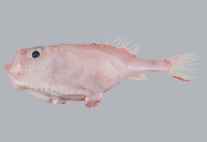Abstract
In this article, a new species of salamander of the genus Bolitoglossa (Eladinea) from the cloud forest near La Mucuy in Sierra Nevada de Mérida, Venezuelan Andes, is described. Bolitoglossa mucuyensis sp. nov. differs from all Venezuelan salamanders, except B. orestes, by a larger SVL/TL ratio, and from La Culata salamander B. orestes by a reduced webbing extension of the front and hind limbs. Additionally, B. mucuyensis sp. nov. and B. orestes diverge 3.12% in terms of the nucleotide sequence of the 16S rRNA gene, as previously reported, and in 8.1% for the cytb gene as shown in this study.
References
Acevedo, A.A., Wake, D., Amézquita, A., Márquez, R., Silva, K. & Franco, R. (2013) Two New species of salamanders, genus Bolitoglossa (Amphibia: Plethodontidae), from the eastern Colombian Andes. Zootaxa, 3609, 69–84. http://dx.doi.org/10.11646/zootaxa.3609.1.5
AmphibiaWeb: Information on amphibian biology and conservation (2012) Berkeley, California: AmphibiaWeb. Available from http://amphibiaweb.org/ (accessed 8 December 2012).
Ataroff, M. & Sarmiento, L. (2004) Las unidades ecológicas de los Andes de Venezuela. In: La Marca, E. & Soriano, P. (eds.), Reptiles de Los Andes de Venezuela, pp. 9–26. Fundación Polar, Conservación Internacional, CODEPRE-ULA, Fundacite Mérida, BIOGEOS.
Barrio-Amorós, C.L. & Fuentes-Ramos, O. (1999) Bolitoglossa spongai a new species of salamander (Caudata: Plethodontidae) of Venezuelan Andes, with comments on the genus in Venezuela. Acta Biologica Venezuelica, 19, 9–19.
Brame Jr., A.H. & Wake, D.B. (1962) A new plethodontid salamander (genus Bolitoglossa) from Venezuela with redescription of the Ecuadorian salamander B. palmata (Werner). Copeia, 1, 170–177. http://dx.doi.org/10.2307/1439493
Brame Jr., A.H. & Wake, D.B. (1963) The salamanders of South America. Los Angeles County Museum, Contributions in Science, 69, 1–72.
Díaz de Pascual, A., García, J. Mora, A. Kiyota, S. & Escalona, M. (2010) Bolitoglossa orestes (Culata climbing salamander) and Bolitoglossa spongai (NCN). Life history. Herpetological Review, 41, 186–187.
Fermin, G., García-Gutiérrez, J. Escalona, M. Mora, A. & Díaz, A. (2012) Molecular taxonomic reassessment of the cloud forest’s Bolitoglossa salamanders (Caudata: Plethodontidae) from Cordillera de Mérida (Mérida state, Venezuela). Zootaxa, 3356, 47–56.
Hall, T.A. (1999) BioEdit: a user-friendly biological sequence alignment editor and analysis program for Windows 95/98/NT. Nucleic Acids Symposium Series, 41, 95–98.
Larkin, M.A., Blackshields, G., Brown, N.P., Chenna, R., McGettigan, P.A., McWilliam, H., Valentin, F., Wallace, I.M., Wilm, A., Lopez, R., Thompson, J.D., Gibson, T.J. & Higgins, D.G. (2007) Clustal W and Clustal X version 2.0. Bioinformatics, 23, 2947–2948. http://dx.doi.org/10.1093/bioinformatics/btm404
Larson, A. & Chippindale, P. (1993) Molecular approaches to the evolutionary biology of plethodontid salamanders. Herpetologica, 49, 204–215.
Moritz, C., Schneider, C.J. & Wake, D.B. (1992) Evolutionary relationships within the Ensatina eschscholtzii complex confirm the ring species interpretation. Systematic Biology, 41, 273–291. http://dx.doi.org/10.2307/2992567
Mueller, R.L., Macey, J.R., Jaekel, M., Wake, D.B. & Boore, J.L. (2004) Morphological homoplasy, life history evolution, and historical biogeography of plethodontid salamanders inferred from complete mitochondrial genomes. Proceedings of the National Academy of Science, USA, 101, 13820–13825. http://dx.doi.org/10.1073/pnas.0405785101
Parra-Olea, G. & Wake, D.B. (2001) Extreme morphological and ecological homoplasy in tropical salamanders. Proceedings of the National Academy of Science, USA, 98, 7888–7891. http://dx.doi.org/10.1073/pnas.131203598
Parra-Olea, G., García-París, M. & Wake, D. (2004) Molecular diversification of salamanders of the tropical American genus Bolitoglossa (Caudata: Plethodontidae) and its evolutionary and biogeographical implications. Biological Journal of the Linnean Society, 81, 325–346. http://dx.doi.org/10.1111/j.1095-8312.2003.00303.x
Schargel, W.E., García-Pérez, J.E. & Smith, E.N. (2002) A new species of Bolitoglossa (Caudata: Plethodontidae) from the Cordillera de Mérida, Venezuela. Proceedings of the Biological Society of Washington, 115, 534–542.
Schargel, W.E. & Rivas-Fuenmayor, G. (2003) Two new country records of salamanders of the genus Bolitoglossa from Colombia and Venezuela. Herpetozoa, 16, 94–95.
Schwarzkopf, T., Riha, S.J., Fahey, T.J. & Degloria, S. (2011) Are cloud forest tree structure and environment related in the Venezuelan Andes? Austral Ecology, 36, 280–289. http://dx.doi.org/10.1111/j.1442-9993.2010.02160.x
Tamura, K., Peterson, D., Peterson, N., Stecher, G., Nei, M. & Kumar, S. (2011) MEGA5: Molecular Evolutionary Genetics Analysis using maximum likelihood, evolutionary distance, and maximum parsimony methods. Molecular Biology and Evolution, 28, 2731–2739. http://dx.doi.org/10.1093/molbev/msr121
Trapido, H. (1942) A new salamander from Venezuela. Boletín de la Sociedad Venezolana de Ciencias Naturales, 8, 297–301.
Vences, M., Thomas, M., Bonett, R.M. & Vieites, D.R. (2005) Deciphering amphibian diversity through DNA barcoding: chances and challenges. Philosophical Transactions of the Royal Society B, 360, 1859–1868. http://dx.doi.org/10.1098/rstb.2005.1717
Vivas, L. (2007) El cuaternario en Venezuela. In: Pantín, G., Reyes, A., Montero, R., Cunill-Grau, P., Márquez, A., Sotillo, A., Aizpúrua, J. & Fontanillas, G. (Eds.), Geo Venezuela, Vol. 2: Medio Físico y Recursos Ambientales. Fundación Empresas Polar, Exlibris, Caracas. pp. 74–126.

